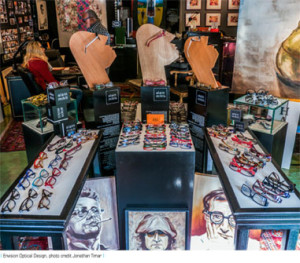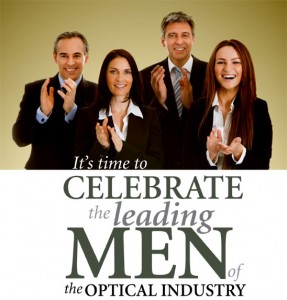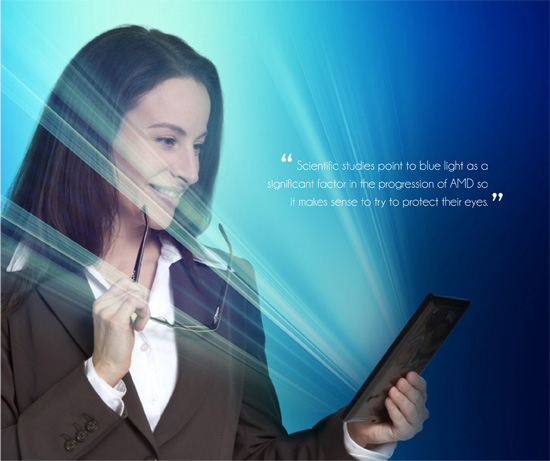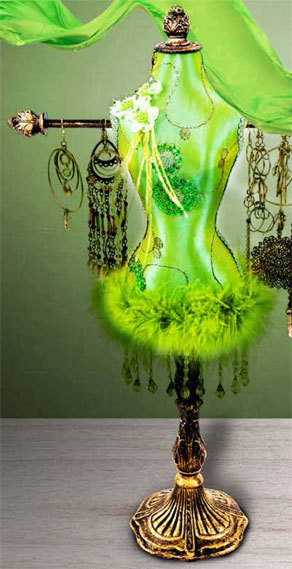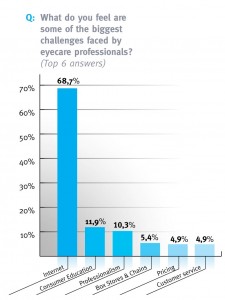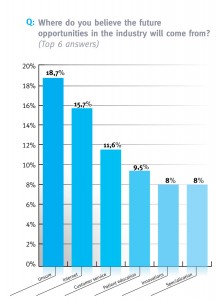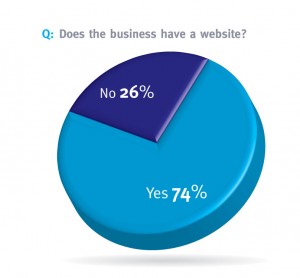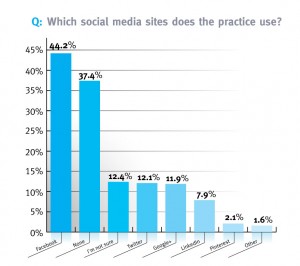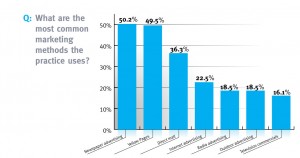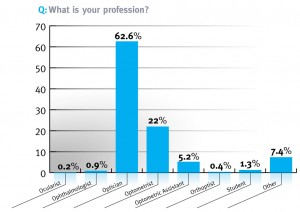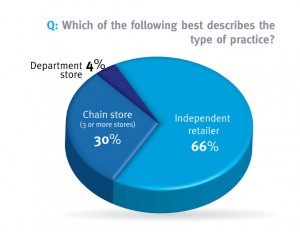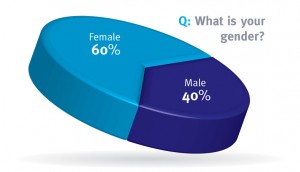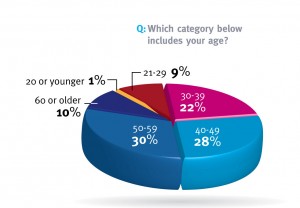By JoAnne Sommers

As an eyecare professional (ECP), what do you say to an elderly patient whose vision is compromised by age-related macular degeneration (AMD), diabetic retinopathy or some other serious eye condition? Are you prepared to discuss low vision assistive devices and rehab services with them? Or are you stymied when lenses are no longer an option for correcting vision problems?
If you haven’t thought much about it, it’s time to start. CNIB estimates that 1.15 million Canadians currently live with blindness or significant vision loss. By 2033, that number is expected to double.
CNIB defines low vision as visual acuity of less than 20/60 but better than 20/200, or a field of vision that is less than 20° across, in the better eye with the best possible correction.
One major reason for the increase in low vision (LV) problems is the “graying” of the population. About 4.9 million Canadians are 65-plus and 460,000 of them have some vision loss. After 40, the incidence of vision loss doubles roughly every decade, reflecting the fact that the risk of vision-impairing conditions such as cataract and AMD rises exponentially with age. Statistics Canada says that by 2026, 20 per cent of Canadians will be seniors, which means the incidence of LV will almost certainly rise dramatically.
Given the health challenges associated with aging, ECPs should watch for conditions that can result in low vision, says Dr. Morrie Sher, an optometrist and LV practitioner with Innisfil Eye Care in Innisfil, ON. When medical treatment isn’t required, ECPs can refer patients to a rehabilitation or LV specialist, or suggest low vision aids such as magnifiers, telescopic devices or special glasses. Electronic aids such as closed-circuit television (CCTV) systems with built-in magnification, and computerized reading devices can also help.
Sher is certified as an authorizer and vendor of LV devices. He refers people to CNIB for high tech devices like computer systems but sells lower tech devices through his practice.
“Many tools are available to help maximize a person’s remaining vision,” he says. “Unfortunately, most ECPs probably don’t know much about them and when a lens can’t  help, they often say there’s nothing more they can do.”
help, they often say there’s nothing more they can do.”
Optometrists and ophthalmologists tend to stick to lens options because it’s what they know best, says Bruce MacKenzie, western region manager for Canadialog, a Toronto-based provider of LV solutions. “Many are reluctant to get into LV because they think too much time and effort is required. As a result, they miss a good opportunity.”
Sher suggests practitioners invite reps from LV companies to demonstrate their products, ask about their most commonly used devices and start testing them out.
Companies like Canadialog, Eschenbach Optik of America, as well as Cecitech and HumanWare, both based in Quebec, welcome the opportunity to work with ECPs. HumanWare, which is owned by Essilor, is focused on working more closely with ECPs, says Canada Sales Director Steven Philips. Eschenbach’s Low Vision Rehabilitation Program for ECPs and rehab professionals consists of product information, training, and ongoing consultative support.
“Essentially it’s a turn-key program for aspiring low vision practitioners looking to add LV services to their practice,” says Ryan Heeney, national sales manager, Canada, for Eschenbach Optik of America, Inc.
While there are many devices on the market you don’t need to stock everything, says Sher. “The technology may seem intimidating but it’s well within an ECP’s scope of understanding. You can also take continuing education courses to learn more.”
Sher says that while working with seniors can take more time than with other patients, it’s very rewarding. “You need patience because it may take longer for them to figure things out. But it’s so satisfying when you can help people to participate again in activities they enjoy and improve their quality of life.”
Here’s What’s New in Low Vision Devices
There is an ever-expanding array of LV solutions on the market, ranging from $50 handheld magnifiers to closed-circuit TVs (CCTVs) that run from $600 and up. The correct choice of device depends largely on the task being performed and the type and degree of vision loss of the patient, says Tim Gels, marketing manager, Eschenbach Optik of America.
“Low vision aids are like a tool kit and different devices are needed for different tasks. For a short-term task like reading a prescription pill bottle, a hand-held magnifier is ideal. For a longer-term task such as reading a book, a stand or spectacle magnifier or a CTTV is better. To help read ticker-tape news at the bottom of a TV screen, a telescopic device is best. A telescopic vision aid can also help with intermediate distance tasks, such as computer work or playing cards.”
Many LV patients purchase three to five devices for various tasks, depending on their activities, says Gels.
Here’s a look at some of the latest LV solutions.
Company: 20/20 Accessory Source
Product: Cocoons Low Vision
Improving sensitivity to contrast is important for people with low vision and requires the use of special optical filters. Low Vision Cocoons are available in four of the most commonly prescribed tints – Boysenberry (plum), Lemon (yellow), Hazelnut (amber) and Orange. Each tint is specifically designed to absorb different amounts of the visible light spectrum. For example, a patient may respond best to the reduction or elimination of scattered blue light, which creates distortion by making the definition of objects less crisp; Hazelnut and Orange lenses from 20/20 Accessory Source are extremely effective for blocking blue light.
The Low Vision Hazelnut lens provides 18 per cent light transmission and 100 per cent UV and infrared protection. It blocks 98 per cent of blue light and all visible light up to 400 nm. These are good general purpose glasses, providing good visual acuity and excellent glare protection. They are very useful for those with retinitis pigmentosa, diabetic retinopathy, pre-cataract and glaucoma.
Low Vision Cocoons with Orange filters have 34 per cent light transmission and block 100 per cent of blue light and all visible light up to 520 nm.The lenses enhance contrast and provide protection from glare. They are helpful to individuals with macular degeneration.
The Lemon lens provides moderate blue light filtering, which is ideal for reading and watching television. Lemon provides 82 per cent light transmission and blocks 100 per cent of UVA/UVB light and all visible light up to 450 nm. It helps increase contrast indoors, but should not really be used in direct sunlight. The tint is better for low light conditions, unless specifically ordered for outdoor use by a low vision specialist.
The Boysenberry lens is ideal for reading and watching television. Boysenberry has 15 per cent light transmission and provides 100 per cent UVA/UVB protection, while blocking all visible light up to 521nm.
Company: Canadialog
Product: MAGic Screen Magnifier
MAGic screen magnification software helps people with low vision view text and images on a computer screen in large size, while hearing the content spoken through a speech synthesizer, if purchased with the speech option.
MAGic lets you magnify a computer screen from 1 to 36 times its usual size. Mouse and cursor enhancements help track the location of the mouse pointer and cursor on the screen. MAGic lets you change the colour of these enhancements, apply transparency effects, adjust their size, and more.
Other magnification features include the Quick View Frame for monitoring important areas of the screen, a Locator feature to help find items, keyboard panning controls, tracking and synchronized highlighting.
Product: RUBY
The RUBY video magnifier is Canadialog’s smallest, most portable handheld magnification solution. The 4.3-inch, full-colour, high brightness video screen makes it outstanding for reading bills, mail and cheques. It fits easily in a pocket or purse.
RUBY XL HD is the new version of RUBY. It has a 5-inch colour HD display that highlights the finest details. You can zoom from 2x to 14x in books, photographs, newspapers and more. 20 high-contrast colour modes allow you to adjust text to your vision.
RUBY XL HD is easy to learn and use. It is equipped with a built-in stand to hold the screen at a natural angle, sliding effortlessly across a document as you read. The command buttons have contrasting colours and tactile cues that make the controls easy to operate. The convenient fold-out handle has two positions for a firm, balanced grip while reading cans and bottles or when reaching to read items on shelves.
With the ability to save 80 images and USB transfer capability, the Ruby XL HD offers clients more features to make their reading experience easier, more useful, and more enjoyable.
The small size allows it to fit in your pocket, making it an ideal travel companion.
Company: Cecitech
Product: VOICEYE™
VOICEYE™ is a smartphone application that enables those who are visually impaired or dyslexic to access printed information using a two-dimensional bar code that is implanted on each printed page.
Users can download the free VOICEYE app from the App Store or Google Play. Once a document is produced with a VOICEYE code, the user can access it with a smartphone, tablet or computer by scanning the code at the top right corner of the page. The text contained in the code is then available on the device. There is no need for a data or Internet connection to decode a VOICEYE code, since the code itself stores the data.
Text can be displayed on the device’s screen in five high-contrast text viewing modes and read aloud with TTS (text-to-speech) software. The scanned information is also retained in the device’s history for easy access later.
In South Korea, the VOICEYE solution has been successfully used in schools for the blind, universities, publishing companies, newspapers and elsewhere. The Korean government uses VOICEYE on official documents, such as social security information and tax bills.
In 2012, VOICEYE won the Bett Award in the ICT Special Educational Needs Solutions category. Bett is an annual trade show in the U.K. that showcases the use of information technology in education.
Product: Zoomax Snow
Zoomax Snow is a pocket-sized, handheld video magnifier that combines quality and low price. It is the lightest device of its kind and easy to use, with only three buttons (for magnifying levels, changing colour and font).
Snow offers a high-quality image and up to 16x magnification in a compact and stylish design. It features 10 viewing modes and smooth magnification adjustment. Freeze frame captures images for comfortable viewing and the user can zoom in/out or change the viewing mode of the still image. It is possible to view images on a TV screen by connecting Snow to the television with a cable. Snow’s rechargeable battery lasts 3.5 hours with continuous use.
Company: Eschenbach
Product: Smartlux Digital
The SmartLux Digital is a revolutionary, portable video magnifier that features a 5″ LCD thin-film transistor (TFT) display. It provides 5x, 7x, 9x, or 12x magnification (even less when used in hand-held mode), along with five different viewing modes: full colour, black on white, white on black, black on yellow, and yellow on black.
Illumination is provided by two hi-tech, surface-mounted-design (SMD) LEDs that last up to 50,000 hours. Three different illumination settings are available (100 per cent, 75 per cent and 50 per cent) and the LEDs can be turned off to avoid screen glare while looking at mobile phones, etc.
Images can be captured on the device and up to 20 can be stored with the ability to change the viewing mode and magnification of those images.
SmartLux Digital features a generous depth of focus and includes a stand that, in its fully extended position, is ideal for reading. In its half-extended position it is ideal for writing. When folded down, the SmartLux Digital is perfect for spotting objects a few feet away like posted restaurant menus, supermarket shelf prices, etc.
The screen is hard-coated for protection and made with an additional anti-glare layer of film. The device is completely portable and fits in a purse or large pocket. The automatic shut-off feature will activate between two and five minutes of non-use to save battery life. The SmartLux Digital comes with a two-year warranty.
Product: Diffractive lens
Eschenbach’s ultra-thin diffractive lens was designed to use in certain of its optical magnifying devices such as eyewear and telescopes. The lens is up to one-quarter the thickness of a comparably powered refractive lens, which makes it lighter and thinner, thereby improving cosmesis – the cosmetic look of the device. Because the new lenses are the same thickness as regular reading glasses, people are more likely to wear them than traditional refractive lenses.
Product: Cera-tec©
Eschenbach has also developed the cera-tec scratch-resistant lens coating. The patented coating minimizes scratches by up to 50 per cent and extends the life of the magnifier.
Company: eSight Corporation
Product: eSight Eyewear
eSight Corporation has launched eSight eyewear, a device that enables some patients with low vision or legal blindness to see. eSight eyewear, which looks like a pair of fit-over sunglasses, uses a high-resolution video camera to capture what the wearer is looking at and deliver the images to a computer. Those images are processed and then projected, in real time, onto two LED screens inside the eyewear, allowing eSight to provide as near-normal vision as the wearer’s conditions permits.
Even in damaged or diseased eyes, eSight can digitally optimize video in a way that awakens the residual function of the remaining, functioning neurons or cones. The eSight-enhanced image causes the remaining photoreceptors to send an improved signal to the brain.
Unlike other assistive technology, eSight is mobile, hands-free and it auto-adapts to work effectively with near, far and mid-range tasks.
eSight has been shown to help people with macular degeneration, diabetic retinopathy, Stargardt’s Disease, ocular albinism, Leber’s Hereditary Optic Neuropathy, cone-rod dystrophy and other low vision conditions. It is best suited for visual acuity between 20/60 and 20/400.
eSight eyewear includes the patient’s prescription lenses and is custom fit for maximum vision and comfort. It is available in select low vision clinics in Canada and the U.S.
Features:
• Magnification from 1.5x to 14x
• Auto-focus enables wearers to quickly change their view
• Separate contrast and brightness features accommodate different lighting
• Freeze capability allows wearers to capture a still shot of an image
• Six custom colour modes make reading easier
• Software is easily updated via computer to keep eSight current
• Unique tilt feature enables wearers to alternate between walking and stationary activities like reading or watching TV
Company: HumanWare
Product: Prodigi™
The new Prodigi personal vision assistant won the Silmo d’Or Award for innovation and creativity in Low Vision technology at Silmo 2013. The Prodigi product line consists of three models: the Prodigi Duo, the Prodigi Tablet, and the Prodigi Desktop.
The Prodigi Duo is a 2-in-1 desktop HD digital electronic magnifier that incorporates a tablet docking station and a screen device (either 20” or 24”). This allows the user to have both a big-screen desktop device, and a go-anywhere magnifier at about the same cost as a traditional desktop system.
Both devices use Touch and Tap technology, and HumanWare’s unique Diamond-Edge Text™ format, which can be magnified up to 80x with no loss of text quality. Several different reading formats can be customized, and there is the choice to turn on the speech capabilities, if the user prefers to listen. Prodigi can also store documents and recall them for reading or listening at home or away. Start-up and training time is simplified with Prodigi’s built-in tutorial wizard, which also sets preferences for the user’s specific reading requirements when it is first plugged in and turned on.
The Prodigi Tablet is a handheld magnifier capable of the same functions as the Prodigi Duo, but in a portable, 5-inch touch screen LCD package that weighs about eight oz. The Tablet is capable of magnification, optical character recognition (OCR), text-to-speech, storage and more, inside a sleek, portable device.
The format of the Prodigi Desktop is similar to the Duo, but it is streamlined and doesn’t offer the tablet. The starting price is one-third less than traditional CCTVs.


